 W
WChinese regional cuisines are the different cuisines found in different provinces and prefectures of China as well as from larger Chinese communities overseas.
 W
WAnhui cuisine, alternatively referred to as Hui cuisine, is one of the Eight Culinary Traditions of Chinese cuisine. It is derived from the native cooking styles of the Huangshan region in southern Anhui Province.
 W
WBeijing cuisine, also known as Jing cuisine, Mandarin cuisine and Peking cuisine and formerly as Beiping cuisine, is the local cuisine of Beijing, the national capital of China.
 W
WBuddhist cuisine is an Asian cuisine that is followed by monks and many believers from areas historically influenced by Mahayana Buddhism. It is vegetarian or vegan, and it is based on the Dharmic concept of ahimsa (non-violence). Vegetarianism is common in other Dharmic faiths such as Hinduism, Jainism and Sikhism, as well as East Asian religions like Taoism. While monks and a minority of believers are vegetarian year-round, many believers follow the Buddhist vegetarian diet for celebrations.
 W
WCantonese or Yue cuisine is the cuisine of the Guangdong province of China, particularly the provincial capital Guangzhou, and the surrounding regions in the Pearl River Delta including Hong Kong and Macau. Strictly speaking, Cantonese cuisine is the cuisine of Guangzhou or of Cantonese speakers, but it often includes the cooking styles of all the speakers of Yue Chinese languages in Guangdong. On the other hand, the Teochew cuisine and Hakka cuisine of Guangdong are considered their own styles, as is neighbouring Guangxi's cuisine despite eastern Guangxi being considered culturally Cantonese due to the presence of ethnic Zhuang influences in the rest of the province. Cantonese cuisine is one of the Eight Culinary Traditions of Chinese cuisine. Its prominence outside China is due to the large number of Cantonese emigrants. Chefs trained in Cantonese cuisine are highly sought after throughout China. Until the late 20th century, most Chinese restaurants in the West served largely Cantonese dishes.
 W
WCuisine of Chinese Muslims is the cuisine of the Hui and other Muslims living in China such as Bonan, Dongxiang, Salar and Uyghurs as well as Dungans of Central Asia.
 W
WFujian cuisine or Fujianese cuisine, also known as Min cuisine or Hokkien cuisine, is one of the native Chinese cuisines derived from the native cooking style of China's Fujian Province, most notably from the provincial capital, Fuzhou. Fujian cuisine is known to be light but flavourful, soft, and tender, with particular emphasis on umami taste, known in Chinese cooking as xianwei, as well as retaining the original flavour of the main ingredients instead of masking them.
 W
WFuzhou cuisine is one of the four subsets of Fujian cuisine, which is one of the Eight Great Traditions of Chinese cuisine. Fuzhou cuisine's taste is light compared to other styles, often with a mixed sweet and sour taste. Fuzhou cuisine displays an influence from the neighboring Zhejiang province's cuisine and as the capital of Fujian, Fuzhou has been influenced more heavily by cuisines from Northern China. It is traditionally considered the most prestigious subset of Fujian cuisine and was a strong influence on Ryukyuan cuisine in Japan.
 W
WGuizhou cuisine, or Qian cuisine, consists of cooking traditions and dishes from Guizhou Province in southwestern China. Guizhou cuisine shares many features with Sichuan cuisine and Hunan cuisine, especially in bringing the sensation of spiciness and pungency. What makes Guizhou cuisine unique is the emphasis of a mixed sour-and-spicy taste, as compared to the numbing-and-hot sensation featured in Sichuan cuisine and the dry-hot taste featured in Hunan cuisine. There is an ancient local saying, "Without eating a sour dish for three days, people will stagger with weak legs". The saying reflects how Guizhou people love local dishes with a sour taste. The combination of sour and spicy flavours is also found in Shaanxi cuisine. Guizhou cuisine differs from Shaanxi cuisine in that it lacks the emphasis on the salty taste, which is a common trait found in most northern Chinese cuisines. In addition, the unique sourness featured in Guizhou cuisine comes from the local tradition of fermenting vegetables or grains, and not from using vinegar products.
 W
WHainan cuisine, or Hainanese cuisine, is derived from the cooking styles of the peoples of Hainan Province in China. The food is lighter, less oily, and more mildly seasoned than that of the Chinese mainland. Seafood predominates the menu, as prawn, crab, and freshwater and ocean fish are widely available.
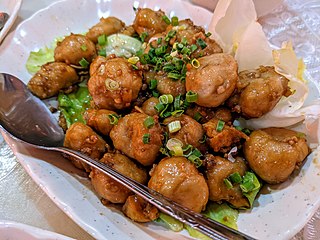 W
WHakka cuisine is the cooking style of the Hakka people, and it may also be found in parts of Taiwan and in countries with significant overseas Hakka communities. There are numerous restaurants in Taiwan, Hong Kong, Indonesia, Malaysia, Singapore, India and Thailand serving Hakka cuisine. Hakka cuisine was listed in 2014 on the first Hong Kong Inventory of Intangible Cultural Heritage.
 W
WHenan or Yu cuisine is an umbrella term used to define the native cooking styles of the Henan province in China. Henan is a province located in Central China and is often also referred to by the names Zhongzhou or Zhongyuan, which means ‘midland’. Being landlocked on all sides, the influence of localized culinary styles are plentiful to be observed in Henan Cuisine. It incorporates a blend of culinary styles from Jiangsu and Beijing, which gives it a unique mix of taste. Henan Cuisine is well known for its taste variety including a blend of sour, sweet, bitter, spicy and salty. The wide variety of Henan dishes is inclusive of Carp with Fried Noodles in Sweet and Sour Sauce, Grilled Head and Tail of Black Carp, Bianjing Roasted Duck, Stewed Noodles with Mutton, Spicy Soup (Hulatang) etc. Despite its mix of all possible flavours within its culinary forms, Henan cuisine is not known to take them to the extreme levels. Rather, Henan cuisine is renowned for inducing a very moderate and balanced mix of flavours in its dishes. Henan has a long cultural history, which not only left us precious cultural relics and historical sites but also Henan cuisine. Henan is in the central part of China, so it is a fusion of the characteristics of both southern and northern, resulting in a unique local cuisine. Henan cuisine, also known as Yu cuisine, has the honor of being one of China’s oldest and most traditional cooking styles. There are more than 50 kinds of cooking methods in preparing Henan cuisine. The history of the province shows its relation to the affinity towards food culture among the people of Henan, where the motive to bring together the different tastes from the north and the south to blend it into one dish.
 W
WHuaiyang cuisine (淮揚菜) is one of the Four Great Traditions in Chinese cuisine. It is derived from the native cooking styles of the region surrounding the lower reaches of the Huai and Yangtze rivers and centered on the cities of Huai'an, Yangzhou and Zhenjiang in Jiangsu Province. Although it is one of several sub-regional styles within Jiangsu cuisine, Huaiyang cuisine is widely seen in Chinese culinary circles as the most popular and prestigious style of Jiangsu cuisine – to a point where it is considered to be one of the Four Great Traditions that dominate the culinary heritage of China, along with Cantonese cuisine, Shandong cuisine and Sichuan cuisine.
 W
WHubei cuisine, also known as Chu cuisine or E cuisine, is derived from the native cooking styles of Hubei Province in China.
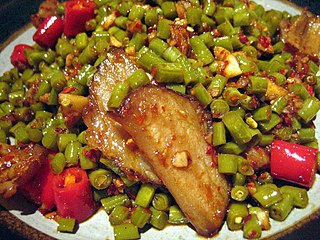 W
WHunan cuisine, also known as Xiang cuisine, consists of the cuisines of the Xiang River region, Dongting Lake and western Hunan Province in China. It is one of the Eight Great Traditions of Chinese cuisine and is well known for its hot and spicy flavours, fresh aroma and deep colours. Common cooking techniques include stewing, frying, pot-roasting, braising and smoking. Due to the high agricultural output of the region, ingredients for Hunan dishes are many and varied.
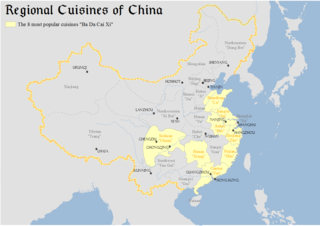 W
WJiangsu cuisine, also known as Su cuisine, is one of the Eight Culinary Traditions of Chinese cuisine. It is derived from the native cooking styles of Jiangsu Province. In general, Jiangsu cuisine's texture is characterised as soft, but not to the point of mushy or falling apart. In addition, Jiangsu cuisine also focuses on heating temperature. For example, the meat tastes quite soft but would not separate from the bone when picked up. As the style of Jiangsu cuisine is typically practised near the sea, fish is a very common ingredient in cooking. Other characteristics include the strict selection of ingredients according to the seasons, with emphasis on the matching colour and shape of each dish and using soup to improve flavour. The municipality of Shanghai was formerly a part of Jiangsu thus the great deal of similarity between the two, and Shanghai cuisine is sometimes classified as a part of Jiangsu cuisine.
 W
WJiangxi cuisine, also known as Gan cuisine, is derived from the native cooking styles of Jiangxi province in southern China.
 W
WLiaoning cuisine is derived from the native cooking styles of the Liaoning Province in China, and it is the most famous Northeastern Chinese cuisine.The main characteristics of Liaoning cuisine is that it is colorful, tastes are strong, food is soft, and one dish has many flavors/tastes, however, the sweet taste and the salty taste are very distinct.
 W
WManchu cuisine or Manchurian cuisine is the cuisine of Manchuria, the historical name for a region which now covers mostly Northeast China and Outer Manchuria. It uses the traditional Manchu staple foods of millet, soybean, peas, corn and broomcorn. It relies heavily on preserved foods due to the harsh winters and scorching summers in Northeast China. Manchu cuisine is also known for grilling, wild meat, strong flavours and the wide use of soy sauce. Manchu cuisine is more wheat based than Han Chinese cuisines.
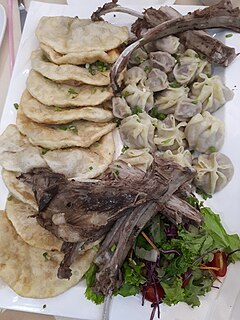 W
WMongolian cuisine predominantly consists of dairy products, meat, and animal fats. The most common rural dish is cooked mutton. In the city, steamed dumplings filled with meat—"buuz"— are popular.
 W
WPutian cuisine, also known as Henghwa cuisine or Henghua cuisine, is a style of Chinese cuisine originating from the Putian people of Putian, Fujian Province. It is a style of Fujian cuisine.
 W
WShaanxi cuisine, or Qin cuisine, is derived from the native cooking styles of Shaanxi Province and parts of northwestern China.
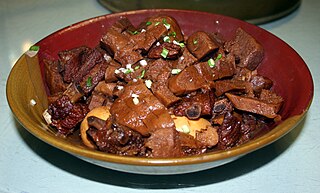 W
WShandong cuisine, more commonly known in Chinese as Lu cuisine, is one of the Eight Culinary Traditions of Chinese cuisine and one of the Four Great Traditions. It is derived from the native cooking style of Shandong Province, a northern coastal province of China.
 W
WShanxi cuisine, or Jin cuisine, is derived from the native cooking styles of Shanxi Province in China. It is famous for noodles, fried flatbread and sour tastes. The cuisine is also famed for using its locally produced vinegar, just like in Huaiyang cuisine, but the flavour is totally different.
 W
WSichuan cuisine, alternatively romanized as Szechwan cuisine or Szechuan cuisine, is a style of Chinese cuisine originating from Sichuan Province. It has bold flavours, particularly the pungency and spiciness resulting from liberal use of garlic and chili peppers, as well as the unique flavour of Sichuan pepper. There are many local variations within Sichuan Province and the neighbouring Chongqing Municipality, which was part of Sichuan Province until 1997. Four sub-styles of Sichuan cuisine include Chongqing, Chengdu, Zigong and Buddhist vegetarian style.
 W
WTeochew cuisine, also known as Chiuchow cuisine, Chaozhou cuisine or Chaoshan cuisine, originated from the Chaoshan region in the eastern part of China's Guangdong Province, which includes the cities of Chaozhou, Shantou and Jieyang. Teochew cuisine bears more similarities to that of Fujian cuisine, particularly Southern Min cuisine, due to the similarity of Chaoshan's and Fujian's culture, language, and their geographic proximity to each other. However, Teochew cuisine is also influenced by Cantonese cuisine in its style and technique.
 W
WTibetan cuisine includes the culinary traditions and practices and its peoples. The cuisine reflects the Tibetan landscape of mountains and plateaus and includes influences from neighbors. It is known for its use of noodles, goat, yak, mutton, dumplings, cheese, butter, yogurt, and soups. Vegetarianism has been debated by religious practitioners since the 11th century but is not prevalent due to the difficulty of growing vegetables, and cultural traditions promoting consumption of meat.
 W
WXinjiang cuisine reflects the cooking styles of many ethnic groups of the Xinjiang region and refers particularly to Uyghur cuisine. Signature ingredients include roasted mutton, kebabs, roasted fish and rice. Because of the Muslim population, the food is predominantly halal.
 W
WYunnan cuisine, alternatively known as Dian cuisine, is an amalgam of the cuisines of the Han Chinese and other ethnic minority groups in Yunnan Province in southwestern China. As the province with the largest number of ethnic minority groups, Yunnan cuisine is vastly varied, and it is difficult to make generalisations. Many Yunnan dishes are quite spicy, and mushrooms are featured prominently. Flowers, ferns, algae and insects may also be eaten. The cuisine of Yunnan is often compared to the cuisine of Southeast Asia as the province borders the region and many of the ethnic minorities or related cultural groups also have a presence in Southeast Asia.
 W
WZhejiang cuisine, alternatively known as Zhe cuisine, is one of the Eight Culinary Traditions of Chinese cuisine. It derives from the traditional ways of cooking in Zhejiang Province, which is located south of Shanghai and centred around Hangzhou, a historical Chinese capital. In general, Zhejiang cuisine is not greasy but has a fresh and soft flavour with a mellow fragrance.